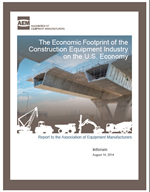A new Association of Equipment Manufacturers report highlights the construction equipment industry’s link to hundreds of thousands of high-paying jobs and billions in economic activity. Authored by Inforum, a University of Maryland research organization, “The Economic Footprint of the Construction Equipment Industry on the U.S. Economy” underscores business growth over the last decade, plus threats posed by diminishing government investment in infrastructure projects and eliminating support for manufacturing exports.

“The construction equipment industry contributes so much to our economy, and this report illustrates the vital importance of ensuring that this industry can continue to flourish and grow,” says AEM President Dennis Slater. “However, this report should also serve as a wake-up call to members of Congress, who can bolster the construction equipment sector by voting to reauthorize the Export-Import Bank, and finally passing a long-term, fully-funded highway bill.”
The report speaks directly to the impact of public policy issues on the industry. Construction equipment exports have more than tripled, from $5.5 billion to $19.5 billion, since 2004. Lawmakers are currently weighing whether to let the charter of the Export-Import Bank, which helps support many exports, expire. The report also calls the trajectory of government spending on infrastructure “the biggest uncertainty” facing the industry, noting how a) such investment has been cut in half since its 1960s peak; and, b) lawmakers’ failure to invest in infrastructure going forward will hurt most Americans. Infrastructure deficiencies will cost each household an average of about $4,500 per year by 2020 and pace $7,800 by 2040, the report contends.
Deficient infrastructure is also projected to reduce cumulative GDP by $900 billion over the next decade. “Failing to invest in our infrastructure won’t just hurt the construction equipment industry,” Slater affirms. “All Americans should be concerned about the costs associated with congressional inaction on major infrastructure projects.”
